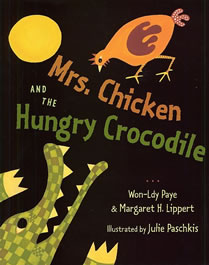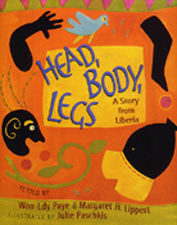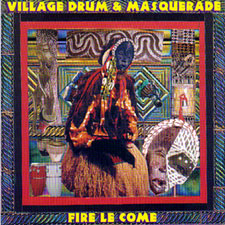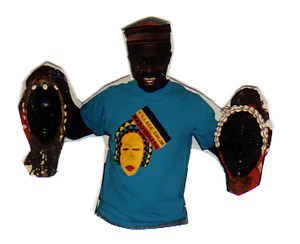Books

By Won-Ldy Paye, Margaret H. Lippert, Julie Paschkis (Illustrator)
Henry Holt and Company, 2003, ISBN: 0-8050-7047-8
Mrs. Chicken can’t see her wings in the puddle, so she walks down to the river where she can admire all of herself. She doesn’t know that Crocodile is there, waiting for dinner—and a tasty chicken would do nicely! To save herself, Mrs. Chicken tells Crocodile that they are sisters.
But how can a speckled chicken and a green-skinned crocodile be related? Mrs. Chicken had better prove that they are, and fast, because Crocodile is getting hungrier . . .
Mrs. Chicken and the Hungry Crocodile is available from bookstores and online merchants. http://www.amazon.com
PARTY AT ISLAND BOOKS
3014 78th Ave SE, Mercer Island
Friday, June 6th
6:30 Live Music & Munchies
7:00 Storytelling
7:30 Booksigning

By Won-Ldy Paye, Margaret H. Lippert, Julie Paschkis (Illustrator) Henry Holt and Company, 2002, ISBN: 0-8050-6570-9
Head is all alone. Body bounces along. Arms swing about, and Legs stand around. They can't do much by themselves, so they try to join together. But how? Should Head attach to the belly button? Should Legs stand on Arms? If only they can work together, everything will be perfect. From the oral tradition of Liberia comes a magical creation story. Head, Body, Legs is available from bookstores and online merchants.www.amazon.com
Head, Body, Legs: A Story from Liberia
- American Library Association—2003 Notable Children's Book
- The Bulletin of the Center for Children's Books—2002 Blue Ribbon Award
- American Folklore Society—Aesop Accolade for 2002
In this light-hearted creation story from the Dan people of eastern Liberia, Head is rolling around wishing he could reach the cherries on top of the tree instead of just eating "things on the ground that he could reach with his tongue." A chance meeting with Arms (which attach themselves to Head) results in Head (and Arms) being able to reach the delicious cherries, after which a nap is in order: "'This,' said Head, 'is perfect.'" Encounters with a stray body and a pair of legs (all apparently at loose ends) result in the first fully formed human being and a very funny story. Paschkis' gouache illustrations (according to the liner notes, inspired by "the Asafo flags of the Fante people from coastal Ghana") have a Matisse-like feel; the spacious compositions are composed of collage-like individual elements set against vivid, sunny colors. Head's simple facial features are remarkably expressive, and the rest-of-the-body language is surprisingly articulate. Beginning readers will appreciate the simple, dialogue-dense text, and the jocular storytelling style and jovial complementary illustrations will make this a favorite of young listeners. A brief source note is included.
JMD From The Bulletin of the Center for Children's Books May, 2002
This humorous story from Liberia's Dan people suggests that all must work together to succeed in life. A disembodied Head rolls along but can't get the cherries or mangoes he wants to eat until he discovers Arms. Arms attach to Head and they are nearly squashed by Body. As Head assembles various parts, each piece attaches itself in a strange way until finally, with the addition of Legs, Head can recompose to make a full person-and those mangoes are delicious. The story is enhanced by expressionistic paintings whose bright-colored backgrounds make the black-and-yellow figures stand out. Colors and patterns were inspired by flags from the Fante people of coastal Ghana. Perfect for flannelboard and silly enough to enchant young listeners, this is a good tale to add to the storytelling repertoire.
By Susan Hepler, Burgundy Farm Country Day School, Alexandria, VA
From School Library Journal April 1, 2002
"Long ago, Head was all by himself." With no arms or legs, Head rolls everywhere and can eat only the things he can reach on the ground. While dreaming of sweet cherries beyond his reach, he meets up with two Arms who cannot see. Together they pick and eat the cherries and are satisfied until they spy a mango tree across the river. Other body parts soon come along, and after they sort themselves into the proper configuration, the newly whole person stands up on tiptoe to pick the delicious mangoes. This simple fable about working together is related in a straightforward text; humor is inherent in the situation of the stray body parts bumping into trees and attaching themselves to one another in impossible ways-head to bellybutton, legs to hands, elbow to chin. Stylized black body shapes move through a setting that suggests lush vegetation: the gouache paintings contain images of plants and animals amid decorative borders and Matisse-like design elements. A brief author's note says that the story from the Dan people of Liberia is told to children "to illustrate the importance of cooperation"; the message is clear but takes second place to the strange and silly tale and the enticing illustrations in ripe fruit colors. By L.A. From The Horn Book Magazine March/April 2002
By Won-Ldy Paye, Margaret H. Lippert, Ashley Bryan (Illustrator)
Fulcrum Publishing, 1998, ISBN: 1-55591-991-X
Discover why Leopard has spots, what happens when Mrs. Chicken meets a hungry crocodile, and how the birds react when Spider flies to their feast. These and other Dan tales are engagingly retold.
Why Leopard Has Spots is available from bookstores and online merchants. http://www.amazon.com
Why Leopard Has Spots: Dan Stories From Liberia
- Westchester County Library System—Anne Izard Storyteller's Choice Award 2002
- Storytelling World—Honor Award for Storytelling Anthologies 2002
- African Studies Association—1999 Best Book for Older Readers
- American Folklore Society—1999 Aesop Accolade Award
Editorial Reviews
"Long ago, Head was all by himself," begins this African creation story about how the human anatomy came to be. "He had no legs, no arms, no body. He rolled everywhere. All he could eat were things on the ground that he could reach with his tongue." Lippert and Paye previously collaborated on Why Leopard Has Spots: Dan Stories from Liberia, and the two here relate this traditional tale of cooperation from Paye's Dan tribe. Bordered in a distinctive lilac and orange pattern of oblong blocks and zig-zags, Paschkis's (Happy Adoption Day) gouache illustration shows "Head," a bold, ebony, free-floating shape resembling an African mask, against a deep blue background. When he attempts to shake down a cherry tree by rolling headlong into the trunk, Head meets Arms and convinces the appendages to form a partnership: "They... attached themselves to Head above the ears." Later, a lime-green wash provides vivid contrast as Head and Arms meet Body and attach themselves just above the sloping arch of his belly. A series of witty images depicts the group as they team up with Legs and negotiate their proper places. The action plays out against a background so saturated with citrus colors that the spreads resemble African fabrics in their beauty and fluidity. This attractive volume delivers its upbeat message with intelligence and humor. From Publishers Weekly April 1, 2002
Featuring strong repetition, lively dialogue, and morals pithily wrought, these six Liberian animal tales will be a boon for story hour. Audiences will enjoy the humor (try ''Why Spider Has a Big Butt''), and storytellers will appreciate the good notes and illuminating glossary. Bib. Copyright © 1999 The Horn Book, Inc. From Horn Book
Gr. 3-5. This is a successful collaboration between a Liberian from the Dan ethnic group, who retells six stories he heard from his grandmother, and a U.S. teacher/storyteller-with Ashley Bryan's rhythmically patterned black-and-white linoleum prints decorating the text. Spider is the main character, and he assumes the varied roles of a trickster, mostly the victim of his own failings and foil of his own jokes-children will especially enjoy "Why Spider Has a Big Butt"! Other tales include "Why Leopard Has Spots," "Mrs. Chicken and the Hungry Crocodile," "The Talking Vegetables," "The Hunger Season," and "Spider Flies to the Feast," all told with an artless simplicity of style that will make them prime-time readalouds, readalones, or storytelling sources. This is an unusually good and accessible collection of tales for this age group-the storytelling voice is fresh and invigorating, and the polished but unglamorized design of the book itself has an easy appeal. An introduction gives cultural background, while several sections at the end of the book provide notes on the stories, a glossary, a bibliography, and a profile of the contributors. By Betsy Hearne The Bulletin for the Center of Children's Books
November 1998
Gr. 3-6. The title story and others in this inviting collection are sure to ring a familiar bell with lovers of African folklore. These lively how-and-why tales with their mostly gentle morals are universal in their appeal and offer traditional mainstays of the lore, such as the lazy, crafty spider and the hungry crocodile. Lovers of Anansi tales will find very similar stories of a lazy spider scheming to get out of working or trying to attend two feasts at the same time. Familiar, too, are Bryan's striking black-and-white linoleum-cut prints that show the power of the eagle's wings and the strong, graceful movement of the crocodile's tail. Together, the art and words make rousing tales for new readers and the initiated.
By Denia Hester From Booklist September 1, 1998
Praise From Other Authors
"What a treasure this book is - stories from a traditional teller put into clear and lyrical prose. These tales beg to leap again off the page, so read them silently, and then aloud."
-Jane Yolen author of Favorite Folktales from Around the World and Owl Moon
"The authentic folktales in this book captivate, entertain, and educate readers of all ages. An excellent resource to have both in school and home.
-Vincent Muli wa Kituku author of East African Folktales: The Voice of Mukamba
"In this finely crafted book Won-Ldy Paye and Margaret H. Lippert offer us an introduction to the vibrant Dan culture of Liberia."
-Diane Wolkstein author of The Magic Orange Tree and Other Haitian Folktales
Awards
- Westchester County Library System -- 2000 Anne Izard Storyteller's Choice Award
- African Studies Association -- 1999 Best Book for Older Readers
- American Folklore Society -- 1999 Aesop Accolade Award
- Storytelling World -- 1999 Honor Award for Storytelling Anthologies
Earth Care:
World Folktales to Talk About
By Margaret Read MacDonald
Linnet Books, 1999
Teacher's
Read Aloud Anthology (Volume I)
Margaret H. Lippert, Anthologist
MacMillan/McGraw-Hill, 1993
Teacher's
Read Aloud Anthology (Volume IV)
Margaret H. Lippert, Anthologist
MacMillan/McGraw-Hill, 1993
Reading
Mastery Plus
SRA/McGraw-Hill, 2002
Market Day
CDs

"Fire Le Come" CD
Nine songs, traditional Liberian music by Village Drum & Masquerade Contact Won-Ldy Paye for ordering information.
Cassette Tapes
Six of storyteller Won-Ldy Paye's best Liberian children's folktales Contact Won-Ldy Paye for ordering information.
Six songs, traditional Liberian music by Village Drum & Masquerade
Contact Won-Ldy Paye for ordering information.
The Village Drum Mask T-Shirt
